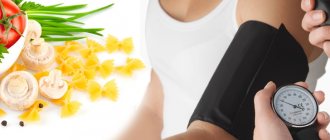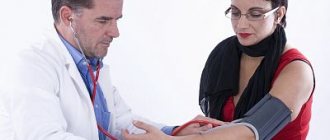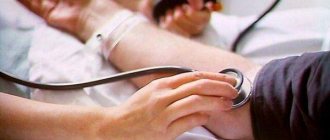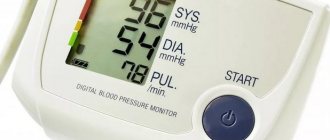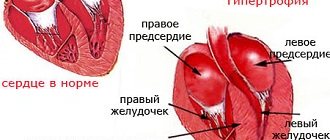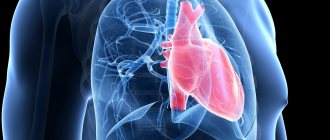Hypotension, or, as this phenomenon is also called, arterial hypotension, is a condition of the human body in which blood pressure is reduced compared to normal levels. The norm is the ratio of systolic (upper) and diastolic (lower) pressure 120/80 mmHg. Art. (small deviations are acceptable). Hypotension is characterized by a decrease in blood pressure below 90/60 mmHg. Art. It is necessary to treat hypotension when it adversely affects the general condition of the human body.
There are several types of physiological lowering of blood pressure:
- hypotension as an individual variant of the norm, not accompanied by any unpleasant symptoms;
- compensatory adaptive hypotension (develops in people living in high mountain areas);
- orthostatic hypotension (due to sudden movement of the body from a horizontal to a vertical position, due to active physical exercise);
- postprandial hypotension (a decrease in blood pressure after eating).
Causes of hypotension
Depending on the causes of this condition, the following forms of hypotension are distinguished.
Primary. This is a special form of neurosis-like disease of the vasomotor centers of the brain. The main causes of primary hypotension: severe stress, prolonged emotional stress.
Secondary. It is often a concomitant pathology with certain diseases of the thyroid gland, hepatitis, anemia, tumor diseases, gastric ulcers, tuberculosis, rheumatism, cirrhosis of the liver, brain injuries, when taking a number of medications, etc.
Often, hypotension is a sign of vegetative-vascular dystonia (VSD), a condition of the body that is characterized by disruption of the autonomic nervous system, which regulates the functioning of organs. This can lead to disruption of the regulation of the cardiovascular system of the nervous and endocrine systems, and, accordingly, to disruption of heart rate, thermoregulation, decreased vascular tone, etc. VSD develops due to hormonal imbalances, neuroses, severe stress and psychological trauma, exposure harmful occupational factors, alcohol abuse.
Hypotension can also develop in healthy people, for example, in athletes with regular physical activity. In this case, low blood pressure acts as a kind of protective reaction of the body. A sharp change in climatic or weather conditions, increased humidity, the action of electromagnetic fields, radiation, etc. can also lead to a decrease in pressure.
Postprandial hypotension
This condition occurs after eating. Blood rushes to the vessels of the abdominal cavity to speed up digestion. A person feels increased heart rate, weakness and drowsiness, dizziness and sweating. Against this background, visual and speech disturbances, characteristic chest pain and even fainting are possible.
This type of hypotension is often called “dinner” hypotension, and it occurs mainly in older people. Provoking factors can be neurological and endocrine diseases, as well as any deviations in mental development, such as neurasthenia or neurosis. Among representatives of the younger generation with good immunity, the body, as a rule, can cope more easily with even large meals - they often do not affect their general condition and blood pressure levels.
Symptoms of hypotension
The main symptom of hypotension is a decrease in blood pressure to 90/60 mm Hg. Art. or lower. Each person can measure their blood pressure independently at home using a tonometer. In addition, signs indicating arterial hypotension include the following:
- feeling of general weakness, lethargy, drowsiness;
- increased sweating;
- disturbances in heat exchange processes (cold extremities);
- increased heart rate;
- sleep disorders;
- emotional instability (periods of irritability, apathy);
- dizziness and headache (mostly dull in the frontal and temporal regions);
- aching pain in the heart;
- dyspnea.
Sometimes hypotension can manifest itself as fainting, especially in rooms where there is little fresh air. In general, people with low blood pressure react negatively to changes in air temperature, changes in air humidity, as well as to various emotional stimuli. Isolated cases of these symptoms may not indicate the presence of hypotension, but if there are several symptoms and they are constant, then you should consult a doctor.
Orthostatic hypotension
This diagnosis is made if the pressure drops sharply during a rapid change in body position, for example after sleep when getting out of bed. Blood is quickly redistributed throughout the body, but the heart cannot cope with the increased load: the heartbeat does not increase to the required level. Due to insufficient heart contractions, there is a rush of blood to the extremities: in turn, the blood supply to the vessels of the brain decreases.
A person feels general weakness, dizziness, and his coordination is impaired, even to the point of fainting. Blood pressure monitoring confirms a drop in pressure, which could be caused by the following factors:
- long bed rest;
- dehydration;
- pregnancy;
- neurological pathologies;
- loss of fluid due to vomiting, diarrhea, or increased sweating;
- taking diuretics.
Consequences and complications of hypotension
Often, rare cases of hypotension, manifested by weakness, lethargy, nausea and other nothing more than unpleasant symptoms, are not accompanied by fatal consequences for the body. They only cause discomfort and reduce performance. However, a constant or systematic decrease in pressure can negatively affect the functioning of the heart, so treatment of hypotension is required.
Cardiac manifestations . People with hypotension have an increased risk of serious cardiovascular problems. A fast pulse means the heart is working hard. This is a kind of compensatory mechanism in order to provide tissues with oxygen, which is lacking due to the slow movement of blood through vessels with low tone. However, a rapid pulse is a serious burden on the heart.
Hypotension and pregnancy . Hypotension during pregnancy is a reason to go to an emergency appointment with a doctor. If the expectant mother systematically experiences low blood pressure, this can lead to oxygen starvation of the fetus due to poor oxygen supply to the placenta. This, in turn, threatens disruptions in the development of the unborn baby. It has been established that pregnant women with low blood pressure experience toxicosis and gestosis more often and more severely. Changes in blood pressure during pregnancy are often difficult to detect: fatigue, weakness, nausea and other signs of hypotension are often confused with characteristic symptoms of pregnancy caused by hormonal imbalance.
It is important to say that a sharp and sudden decrease in pressure with a deterioration in health may indicate intense internal bleeding, a heart attack and other internal problems that pose a threat to human life. In such cases, you should immediately consult a doctor (call an ambulance).
Hypotension and its causes Low blood pressure (doctors also call it arterial hypotension) is considered a condition in which blood pressure drops below 100/60 mm Hg. in men and below 95/60 mm Hg. among women. For older people, blood pressure is below 105/65 mmHg. is already considered reduced. Low blood pressure is not necessarily a sign of poor health. There is also so-called physiological hypotension. At the same time, against the background of low blood pressure, the person feels great, has normal performance, and has no complaints. Pathologically low blood pressure brings many problems to people. Often, a predisposition to low blood pressure is inherited from parents who suffered from this disease. In most cases, this problem worries women. A tendency to low blood pressure is usually observed from childhood. Such children are lethargic, inactive, and quickly get tired of playing with their peers. Hypotonic adults are characterized by a so-called asthenic constitution - tall height and low weight. Most of them are thin people with pale skin. Who suffers from hypotension? The overwhelming majority of these are people who have been subjected to strong and prolonged psycho-emotional stress. Another possible cause may be prolonged mental stress, as a result of which the body falls into a state of decompensation. A traumatic brain injury can also leave behind a trace in the form of low blood pressure. Occupational hazards, such as high noise levels, vibration, overheating, can in turn lead to disruption of the functioning of the vasomotor centers. Many hypotensive patients suffered severe infections in childhood or their nutrition was disrupted. Pathologically low blood pressure is often recorded in people exposed to ionizing radiation. The most common cause of hypotension is autonomic vascular dysfunction. The next most common cause is pathology of the endocrine glands. Main symptoms. Most of the unpleasant symptoms of low blood pressure are associated with impaired blood circulation in the vessels of the brain. In this case, a throbbing pain is felt in the temples, less often in the back of the head. But pain in another location (in the forehead, heaviness in the temples) may also bother you. Often there are migraine-like pains localized in one half of the head. They may be accompanied by nausea and vomiting. The pain is dull and constant. Many people note the appearance of complaints when the weather changes, during magnetic storms. Dizziness and darkening of the eyes are often a concern, especially when suddenly getting out of bed. Some hypotensive patients experience fainting, but they are rare. Another symptom that is often found in hypotensive patients is weakness and fatigue. By the end of the working day, these people feel a decrease in performance. Concerned about absent-mindedness, memory loss. As a result of a slowdown in blood flow, the vital activity of the body decreases. Often, hypotensive people are irritable, emotionally unstable, subject to sudden mood swings, and prone to depression. Reduced vascular tone creates certain disturbances in the functioning of the heart, which can manifest itself as pain behind the sternum and in the cardiac region. These unpleasant sensations are permanent and may be accompanied by palpitations and sensations of interruptions in the functioning of the heart, not associated with physical or nervous stress. Hypotonic people seem to lack air; they yawn constantly. More often, sensations of lack of air occur during physical activity. People with low blood pressure often experience coldness and numbness in their hands and feet, and increased sensitivity to heat and cold. Emergency care for acute drop in blood pressure. What should you do if the person next to you feels worse, feels dizzy, gets dark in his eyes, turns pale? Unfortunately, this sometimes happens to hypotensive people, especially in a stuffy room in the hot sun. In this case, you need not to get confused and take the following measures: 1. The person needs to be put down as quickly as possible, since in this position the blood supply to the brain is facilitated. 2. The head should be positioned as low as possible; you should not place a pillow, as in this position the blood flow to the brain is hampered. 3. If it is not possible to lay the person down, you should sit him down, lowering his head as low as possible between his knees. Be sure to give water or tea to drink. 4. A couple of essential oils have a beneficial effect in such a situation. A bottle with a mixture of rosemary and camphor oils or peppermint oil just needs to be brought to the person’s nose. A few breaths are usually enough to restore well-being. You can put a few drops on a handkerchief and periodically bring it to your nose. Normalizing blood pressure includes various wellness procedures: regular physical exercise, massage, water and air procedures. They have a positive, tonic effect on the body, normalize the functioning of the nervous system, and therefore the functioning of internal organs. Herbs and herbal infusions have proven themselves to be effective against low blood pressure. However, before starting treatment, you must consult your doctor. Phytotherapy. 1. Cinnamon rose hips – 40 g; Lungwort herb – 30 g; stinging nettle leaves – 30 g; black currant fruits – 20 g; common barberry fruits – 20 g. 2. Common chicory root – 30 g; lanceolate plantain leaves – 30 g; black currant leaves – 30 g; stinging nettle leaves – 30 g; dandelion root – 20 g. 3. Red rowan fruits – 40 g; creeping wheatgrass rhizomes – 30 g; wild strawberry leaves – 25 g; small centaury herb – 10 g. The herbal infusions described in recipes 1-3 are prepared according to the same scheme: mix the prepared ingredients. Take 2 tbsp. spoons of herbal mixture and pour 400 ml of boiling water over them. Leave to infuse for 4 hours. Strain. Take 100 ml 3 times a day before meals. 4. Black currant leaves – 30 g; crushed cinnamon rose hips – 30 g; stinging nettle leaves – 30 g; silver birch leaves – 30 g; wild strawberry leaves – 20 g. 1 tbsp. Pour 250 ml of boiling water over a spoonful of herbal mixture. Bring to a simmer over low heat for 2 minutes. Then leave to infuse for 1 hour. Strain. Take ½ glass 3-4 times a day before meals. Simple rules for hypotension 1. For hypotension, the best medicine is movement, not lying on the couch. Physical activity improves the supply of oxygen to the brain and other organs. By loading your body, you will sleep better, and, therefore, you will feel more alert in the morning. 2. Eat lightly. Overeating leads to strain on the digestive processes and energy consumption. Eat as much as you need, but not to the point of feeling drowsy. 3. Don't skip meals, especially breakfast. Low sugar content is bad for brain function. If you are not hungry, you can eat some fruit. This will maintain the desired sugar level and saturate the body with vitamins and microelements. 4. Be careful with coffee. You should not overuse this invigorating drink, otherwise you risk becoming a coffee addict. A cup of coffee in the morning may be necessary for you. But she should follow a light breakfast, under no circumstances on an empty stomach. Try to drink no more than 2 cups of coffee a day, and after lunch it is better not to drink it at all. 5. For many hypotensive patients, daytime sleep is a good medicine. Don't neglect this in your free time. If you do not suffer from insomnia, 15-20 minutes of sleep during the day will do you good, replenish your energy and give you vigor. 6. Allow yourself to relax. Sometimes it's very difficult. But the body needs rest in order to regain strength and energy. Massage and aromatic baths not only relieve muscle fatigue, but also give energy. 7. Think positively. Our thinking largely determines our condition. Tune in for luck, imagine how you will feel when you achieve your goal. Instead of thinking about the hassles of the task at hand, think about the satisfaction you will have when you complete it.
Diagnosis of hypotension
To diagnose hypotension, the therapist performs a number of actions:
- carefully collects complaints, analyzes the description of each of the symptoms of hypotension;
- finds out whether there is a hereditary predisposition, negative factors, etc.
- examines the patient and listens to the heart and lungs;
- performs thorough three-time pressure measurements, and, if necessary, establishes pressure monitoring for a week or more, daily pressure monitoring;
- gives a referral to a cardiologist, neurologist or endocrinologist;
- analyzes the conclusion on the composition of blood and urine, which includes a general and biochemical analysis, a blood test for glucose levels, protein spectrum, ion composition;
- determines the level of catecholamines and endocrine profile in urine and blood;
- refers for ultrasound of the heart, Doppler, electrocardiography;
- performs load tests.
In some cases, additional studies are performed before treatment: CT or MRI of the head, ultrasound of the kidneys, adrenal glands, and thyroid gland.
Diagnosis of arterial hypotension
The appearance of one or several symptoms of arterial hypotension is a reason to visit a general practitioner and cardiologist. To make a diagnosis, the doctor collects a complete medical history of the patient and conducts a series of studies. First of all, blood pressure is measured several times at short intervals. Low blood pressure readings (100/60 and below) indicate the presence of pathology. If necessary, the doctor measures blood pressure during a stress test that simulates high physical activity. Among the mandatory types of examination for hypotension is also an ECG. If necessary and if structural pathologies are suspected, vascular Dopplerography may be required. All this requires certain equipment of the clinic and appropriate skills among the staff.
In our medical center, all diagnostic procedures are performed by doctors who have extensive experience in eliminating vascular pathologies. Here you will always find a professional approach to the diagnosis and treatment of arterial hypotension of any etiology, occurring independently or against the background of other disorders.
Treatment of hypotension
If hypotension is a sign of another disease, treat it. In case of primary hypotension not associated with other diseases, comprehensive non-drug and medicinal measures are carried out to prevent secondary changes in organs and systems associated with chronic lack of oxygen.
General recommendations. Patients are advised to follow a strict daily regimen, including adequate sleep, a reasonable ratio of work and rest, good nutrition, dosed physical activity, walking for at least 2 hours a day, regular airing of rooms, humidification of the air, giving up bad habits, sudden changes in body position, hardening and etc.
Medication correction. To normalize vascular tone, heart rate, and neutralize the effects of negative environmental factors, the following groups of drugs are prescribed: adaptogens, psychomotor stimulants, analeptic drugs, adrenomimetics (for emergency care in case of a sharp drop in pressure), anticholinergics (for vagotonia), nootropics, complexes of vitamins and minerals and etc.
Phytotherapy. Drug treatment of hypotension can be accompanied by taking general tonic adaptogen drugs, stimulants (in particular, coffee and tea), baths with plant decoctions, consumption of herbal infusions, etc.
Physiotherapy. Hypotension therapy is often supplemented with physiotherapeutic methods such as electrophoresis with novocaine, potassium iodide endonasally or orbital-occipital technique, electric sleep and ultraviolet irradiation of the skin, microwave therapy on the adrenal gland area, hot chest wraps, massage, oxygen baths, douches and rubdowns, etc.
Risk factors for hypotension (hypotonic disease, arterial hypotension)
The predisposition to hypotension is inherited from parents. Hypotension is more often observed in women. As a rule, hypotension is observed from childhood; such children are lethargic, inactive, and quickly get tired of playing with their peers. Many hypotensive patients suffered severe infections in childhood. In adolescents, the body undergoes powerful hormonal changes; hypotension serves as an indicator of imperfect adaptation of the autonomic nervous system during rapid growth of the body.
Adults with hypotension are characterized by an asthenic constitution - tall height with low weight. Hypotension mainly affects people who have been exposed to severe and prolonged stress.
Occupational hazards - high noise levels, vibration, overheating - can lead to disruption of the functioning of the vasomotor centers. Pathologically low blood pressure is often recorded in people exposed to ionizing radiation.
Prevention of hypotension
In order to prevent the development of hypotension, it is recommended to follow the following rules of prevention and a healthy lifestyle:
- eat well;
- strictly adhere to the daily routine, sleep at least 8 hours a day;
- be physically active in order to constantly keep blood vessels in good shape (running, swimming, walking in the fresh air);
- give up bad habits, control body weight;
- Monitor your blood pressure and visit your doctor regularly.
If you require diagnosis or treatment of hypotension, contact the ABC-Medicine clinic. If you have any questions or make an appointment, you can call +7 (495) 223?38?83.
Complications of hypotension (hypotonic disease, arterial hypotension)
A hypotonic crisis may develop. The crisis is provoked by neuropsychic overstrain and significant physical activity. It lasts from 10 minutes or more, and may be accompanied by pain or a feeling of sinking in the heart, a feeling of lack of air, and dizziness. The skin is pale and moist, blood pressure is low, and the heart rate may also decrease. After the end of the crisis and normalization of pressure, severe weakness, lethargy, and drowsiness persist for some time.
An acute decrease in pressure is dangerous due to the development of shock - this is a condition when low blood pressure and impaired blood circulation in tissues lead to the development of serious disturbances in the functioning of cells. It manifests itself as pallor of the skin and mucous membranes. The skin becomes cold and damp. The patient feels dizziness, darkening of the eyes, thirst, dry mouth, increasing weakness, anxiety, and sometimes fear. The condition of a sharp decrease in blood pressure requires emergency medical attention.
Hypotension may develop:
- cerebral hypotonic crisis;
- cardiac hypotensive crisis;
- cerebral stroke;
- myocardial infarction;
- thrombophlebitis;
- vascular thrombosis.
Which disease is more dangerous?
Both diseases are dangerous for humans and, in the absence of timely treatment, can lead to a number of negative consequences. Hypertension is accompanied by impaired blood supply to tissues and internal organs. As a result of this, the muscular organ functions with increased load, and a compensatory increase occurs. This can lead to the following ailments: decreased vision, poor circulation, the development of coronary heart disease and acute renal failure.
Hypotension significantly reduces the level of quality of life and seriously affects ability to work. If it continues for a long time, the patient may begin bleeding from internal organs and develop diseases of the endocrine system (for example, hypothyroidism).
Publication date: 04/25/2018 14:24:06
Treatment and rehabilitation for hypotension (hypotonic disease, arterial hypotension)
The patient needs:
- night sleep at least 8 hours a day;
- physical exercises - gymnastics (link: cheerful morning: exercises for hypotension), swimming, walking.
Among medications, drugs with a sedative effect are mainly used, since patients are often irritated, tearful, and experience a feeling of anxiety and fear. In addition, tonics are used (rhodiola rosea, echinacea, leuzea, pantocrine, ginseng, aralia in the form of tinctures and extracts). A combination of tonic and sedative substances gives a positive result.
Physiotherapeutic methods are widely used in the complex treatment of hypotension. These are various types of hydrotherapy - underwater massage shower, therapeutic shower (fan, rain, circular, contrast), baths (sodium chloride, radon, nitrogen, iodine-bromine).
A good effect is observed during courses of therapeutic manual massage of the neck and upper back. Of the hardware methods, electrosleep, aeroionotherapy (inhalation of air enriched with ozone), galvanic collar, darsonvalization of the neck and scalp, as well as the heart area are very useful.
Causes of low blood pressure
In old age, with vessels affected by atherosclerosis, low pressure can occur due to decreased tone of the smooth muscles of blood vessels and the heart muscle. During vagaries of weather and monthly hormonal fluctuations, the decrease in pressure can be significant.
Hypotension can be a consequence of nervous overstrain; it often develops as a consequence of infectious and other diseases, after viral and colds, flu, in the legs, as well as with insufficient or disordered nutrition, restrictive diets.
